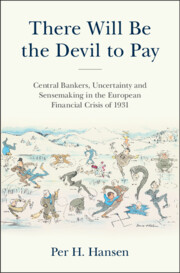 There Will Be the Devil to Pay
There Will Be the Devil to Pay Book contents
- There Will Be the Devil to Pay
- Studies in Macroeconomic History
- There Will Be the Devil to Pay
- Copyright page
- Contents
- Frontispiece
- 1 Introduction
- 2 Central Bankers and Their World
- 3 Preparing for Crisis (May 11–May 19)
- 4 Foreign Creditors (May 16–May 25)
- 5 Moratorium or Guarantee? (May 25–May 27)
- 6 Guarantee at Last? (May 26–June 1)
- 7 Releasing the BIS Credit (May 29–June 5)
- 8 Surrounded with Trouble (June 5–June 10)
- 9 Where and How to Place? (June 8–June 13)
- 10 A World Political Problem (June 11–June 16)
- 11 Francis Rodd Makes Sense – and a Plot (June 9–June 20)
- 12 To Act Now If We Are to Act at All (June 16–June 27)
- 13 Germany Will Collapse (June 19–July 10)
- 14 Anxiety within Germany at Climax (July 11–July 23)
- 15 Going Off the Gold Standard? (July 14–August 21)
- 16 We Must Not Fool Ourselves Now (August 21–September 17)
- 17 As for the Future of England (September 16–October 23)
- The End (2024)
- Timeline
- Actors in the 1931 Financial Crisis Archives
- Acknowledgements
- Archives
- Notes
- Bibliography
- Index
The End (2024)
Published online by Cambridge University Press: 21 December 2024
- There Will Be the Devil to Pay
- Studies in Macroeconomic History
- There Will Be the Devil to Pay
- Copyright page
- Contents
- Frontispiece
- 1 Introduction
- 2 Central Bankers and Their World
- 3 Preparing for Crisis (May 11–May 19)
- 4 Foreign Creditors (May 16–May 25)
- 5 Moratorium or Guarantee? (May 25–May 27)
- 6 Guarantee at Last? (May 26–June 1)
- 7 Releasing the BIS Credit (May 29–June 5)
- 8 Surrounded with Trouble (June 5–June 10)
- 9 Where and How to Place? (June 8–June 13)
- 10 A World Political Problem (June 11–June 16)
- 11 Francis Rodd Makes Sense – and a Plot (June 9–June 20)
- 12 To Act Now If We Are to Act at All (June 16–June 27)
- 13 Germany Will Collapse (June 19–July 10)
- 14 Anxiety within Germany at Climax (July 11–July 23)
- 15 Going Off the Gold Standard? (July 14–August 21)
- 16 We Must Not Fool Ourselves Now (August 21–September 17)
- 17 As for the Future of England (September 16–October 23)
- The End (2024)
- Timeline
- Actors in the 1931 Financial Crisis Archives
- Acknowledgements
- Archives
- Notes
- Bibliography
- Index
Summary
Chapter 18, The End (1931 - 2022). Since the narrative IS the analysis, there is no conclusion as such. Instead, The End provides a discussion of what a forward looking, thick description, humanistic approach to the financial crisis of 1931 have contributed to our knowledge in combination with the concepts embodied in the narrative. First, it is argued that the historical narrative provides new information exactly because writing the history forward brings out the uncertainty and need for sensemaking and narrative emplotment. This argument is discussed briefly in the context of the historiography of the 1931 crisis. Secondly, I ask what this narrative approach has contributed to our emprical and theoretical understanding of decision-making. By very briefly comparing with the Great financial crisis of 2008 I argue that uncertainty is a basic condition that requires sensemaking and narrative construction. I end by suggesting that rather than drawing lessons from history, history can be used as a way to reflect upon the past and the present.
Keywords
- Type
- Chapter
- Information
- There Will Be the Devil to PayCentral Bankers, Uncertainty and Sensemaking in the European Financial Crisis of 1931, pp. 342 - 356Publisher: Cambridge University PressPrint publication year: 2025
